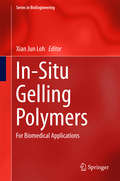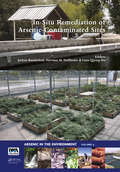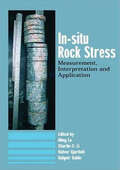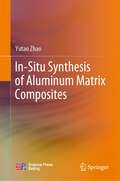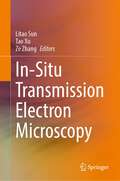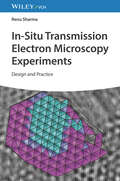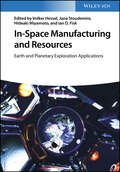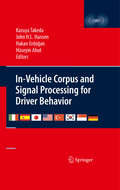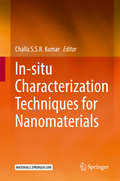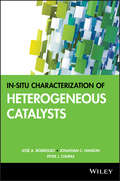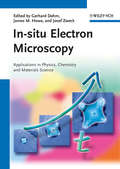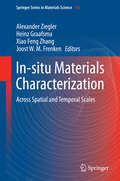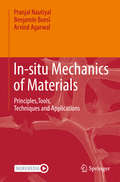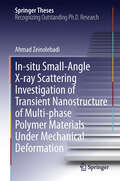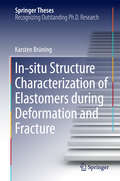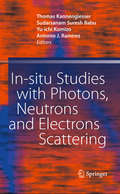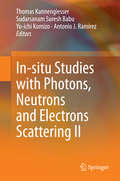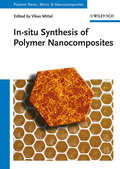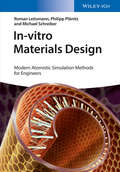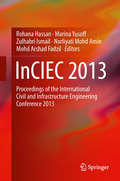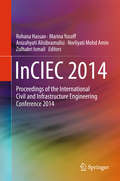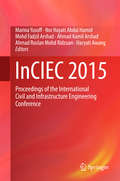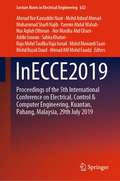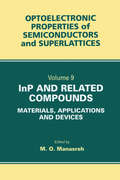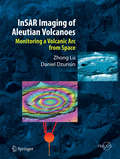- Table View
- List View
In-Situ Gelling Polymers
by Xian Jun LohThis book presents the research involving in situ gelling polymers and can be used as a guidebook for academics, industrialists and postgraduates interested in this area. This work summaries the academic contributions from the top authorities in the field and explore the fundamental principles of in situ gelling polymeric networks, along with examples of their major applications. This book aims to provide an up-to-date resource of in situ gelling polymer research.
In-Situ Remediation of Arsenic-Contaminated Sites (Arsenic in the environment)
by Jochen Bundschuh Hartmut M. Holländer Lena Qiying MaProviding an introduction, the scientific background, case studies and future perspectives of in-situ arsenic remediation technologies for soils, soil water and groundwater at geogenic and anthropogenic contaminated sites. The case studies present in-situ technologies about natural arsenic, specifically arsenate and arsenite, but also about organic arsenic compounds. This work covers geochemical, microbiological and plant ecological solutions for arsenic remediation.It will serve as a standard textbook for (post-)graduate students and researchers in the field of Environmental Sciences and Hydrogeochemistry as well as researchers, engineers, environmental scientists and chemists, toxicologists, medical scientists and even for general public seeking an in-depth view of arsenic which had been classed as a carcinogen. This book aims to stimulate awareness among administrators, policy makers and company executives of in-situ remediation technologies at sites contamined by arsenic and to improve the international cooperation on the subject.
In-Situ Rock Stress: International Symposium on In-Situ Rock Stress, Trondheim, Norway,19-21 June 2006
by Ming Lu Charlie C. Li Halvor Kjørholt Halgeir DahleUnderstanding the stress state in the earth's crust is crucial for engineers working in rock, particularly with regard to underground construction. Experience shows that an adequately high horizontal in-situ stress has a positive effect in stabilizing large span rock caverns close to the ground surface. On the other hand, high stresses resulting fr
In-Situ Synthesis of Aluminum Matrix Composites
by Yutao ZhaoThis book comprehensively and systematically discusses in situ aluminum matrix composites, from their system design, material development, and preparation technology, to their solidification structure, plastic processing, and properties. As a new type of metal matrix composite, it not only provides a technical framework for the low-cost, large-scale development of high-performance compliant materials, but also provides important technical support for the promotion of the aluminum industry. The book appeals to researchers and industrial practitioners in the area of materials development for in situ aluminum matrix composites.
In-Situ Transmission Electron Microscopy
by Tao Xu Ze Zhang Litao SunThis book focuses on in-situ transmission electron microscopy (TEM), an investigatory technique used to observe a sample’s response to a given stimulus (including electron irradiation, thermal excitation, mechanical force, optical excitation, electric and magnetic fields) at the nanoscale in real time. The book introduces readers to the technical strategy behind the in-situ technique and its developments. It reviews the research frontiers of using in-situ TEM in energy conversion and storage, catalysis, nanomaterials synthesis, nanoelectronics, etc. Furthermore, it discusses the future prospects for in-situ TEM. The book offers a valuable guide for all undergraduate and graduate students who are interested in TEM characterization technology. It also serves as a reference source on cutting-edge in-situ techniques for researchers and engineers.
In-Situ Transmission Electron Microscopy Experiments: Design and Practice
by Renu SharmaIn-Situ Transmission Electron Microscopy Experiments Design and execute cutting-edge experiments with transmission electron microscopy using this essential guide In-situ microscopy is a recently-discovered and rapidly-developing approach to transmission electron microscopy (TEM) that allows for the study of atomic and/or molecular changes and processes while they are in progress. Experimental specimens are subjected to stimuli that replicate near real-world conditions and their effects are observed at a previously unprecedented scale. Though in-situ microscopy is becoming an increasingly important approach to TEM, there are no current texts combining an up-to-date overview of this cutting-edge set of techniques with the experience of in-situ TEM professionals. In-Situ Transmission Electron Microscopy Experiments meets this need with a work that synthesizes the collective experience of myriad collaborators. It constitutes a comprehensive guide for planning and performing in-situ TEM measurements, incorporating both fundamental principles and novel techniques. Its combination of technical detail and practical how-to advice makes it an indispensable introduction to this area of research. In-Situ Transmission Electron Microscopy Experiments readers will also find: Coverage of the entire experimental process, from method selection to experiment design to measurement and data analysis Detailed treatment of multimodal and correlative microscopy, data processing and machine learning, and more Discussion of future challenges and opportunities facing this field of research In-Situ Transmission Electron Microscopy Experiments is essential for graduate students, post-doctoral fellows, and early career researchers entering the field of in-situ TEM.
In-Space Manufacturing and Resources: Earth and Planetary Exploration Applications
by Volker Hessel Jana Stoudemire Hideaki Miyamoto Ian D. FiskIn-Space Manufacturing and Resources Comprehensive resource covering all in-space manufacturing and planetary resource exploration endeavors. The space economy is developing quickly, and pivotal events have brought us to a strong inflection point. This unique book includes fundamental and ground-breaking innovations in the field and is meant to quickly get readers up to speed on many different facets of space and planetary resource exploration, such as: Space health & medicine Space biology & space farming Space chemistry & space mining Space construction & advanced materials production Space policy, law & economics Presenting a snapshot of the expanding space economy and manufacturing applications in low-Earth orbit, along with resource utilization capabilities in development for Moon and Mars missions, this an indispensable source for all researchers and commercial companies working on space and planetary resource exploration.
In-Vehicle Corpus and Signal Processing for Driver Behavior
by Kazuya Takeda Hakan Erdogan John Hansen Huseyin AbutIn-Vehicle Corpus and Signal Processing for Driver Behavior is comprised of expanded papers from the third biennial DSPinCARS held in Istanbul in June 2007. The goal is to bring together scholars working on the latest techniques, standards, and emerging deployment on this central field of living at the age of wireless communications, smart vehicles, and human-machine-assisted safer and comfortable driving. Topics covered in this book include: improved vehicle safety; safe driver assistance systems; smart vehicles; wireless LAN-based vehicular location information processing; EEG emotion recognition systems; and new methods for predicting driving actions using driving signals. In-Vehicle Corpus and Signal Processing for Driver Behavior is appropriate for researchers, engineers, and professionals working in signal processing technologies, next generation vehicle design, and networks for mobile platforms.
In-situ Characterization Techniques for Nanomaterials
by Challa S.S.R. KumarSeventh volume of a 40 volume series on nanoscience and nanotechnology, edited by the renowned scientist Challa S.S.R. Kumar. This handbook gives a comprehensive overview about In-situ Characterization Techniques for Nanomaterials. Modern applications and state-of-the-art techniques are covered and make this volume an essential reading for research scientists in academia and industry.
In-situ Characterization of Heterogeneous Catalysts
by José A. Rodriguez Jonathan C. Hanson Peter J. ChupasHELPS RESEARCHERS DEVELOP NEW CATALYSTS FOR SUSTAINABLE FUEL AND CHEMICAL PRODUCTION Reviewing the latest developments in the field, this book explores the in-situ characterization of heterogeneous catalysts, enabling readers to take full advantage of the sophisticated techniques used to study heterogeneous catalysts and reaction mechanisms. In using these techniques, readers can learn to improve the selectivity and the performance of catalysts and how to prepare catalysts as efficiently as possible, with minimum waste. In-situ Characterization of Heterogeneous Catalysts features contributions from leading experts in the field of catalysis. It begins with an introduction to the fundamentals and then covers: Characterization of electronic and structural properties of catalysts using X-ray absorption fine structure spectroscopy Techniques for structural characterization based on X-ray diffraction, neutron scattering, and pair distribution function analysis Microscopy and morphological studies Techniques for studying the interaction of adsorbates with catalyst surfaces, including infrared spectroscopy, Raman spectroscopy, EPR, and moderate pressure XPS Integration of techniques that provide information on the structural properties of catalysts with techniques that facilitate the study of surface reactions Throughout the book, detailed examples illustrate how techniques for studying catalysts and reaction mechanisms can be applied to solve a broad range of problems in heterogeneous catalysis. Detailed figures help readers better understand how and why the techniques discussed in the book work. At the end of each chapter, an extensive set of references leads to the primary literature in the field. By explaining step by step modern techniques for the in-situ characterization of heterogeneous catalysts, this book enables chemical scientists and engineers to better understand catalyst behavior and design new catalysts for green, sustainable fuel and chemical production.
In-situ Electron Microscopy
by Gerhard Dehm James M. Howe Josef ZweckAdopting a didactical approach from fundamentals to actual experiments and applications, this handbook and ready reference coversreal-time observations using modern scanning electron microscopy and transmission electron microscopy, while also providing informationon the required stages and samples. The text begins with introductory material and the basics, before describing advancements and applications in dynamic transmission electron microscopy and reflection electron microscopy. Subsequently, the techniques needed to determine growth processes, chemical reactions and oxidation, irradiation effects, mechanical, magnetic, and ferroelectric properties as well as cathodoluminiscence and electromigration are discussed.
In-situ Materials Characterization
by Alexander Ziegler Heinz Graafsma Xiao Feng Zhang Joost W. M. FrenkenThe behavior of nanoscale materials can change rapidly with time either because the environment changes rapidly or because the influence of the environment propagates quickly across the intrinsically small dimensions of nanoscale materials. Extremely fast time resolution studies using X-rays, electrons and neutrons are of very high interest to many researchers and is a fast-evolving and interesting field for the study of dynamic processes. Therefore, in situ structural characterization and measurements of structure-property relationships covering several decades of length and time scales (from atoms to millimeters and femtoseconds to hours) with high spatial and temporal resolutions are crucially important to understand the synthesis and behavior of multidimensional materials. The techniques described in this book will permit access to the real-time dynamics of materials, surface processes and chemical and biological reactions at various time scales. This book provides an interdisciplinary reference for research using in situ techniques to capture the real-time structural and property responses of materials to surrounding fields using electron, optical and x-ray microscopies (e. g. scanning, transmission and low-energy electron microscopy and scanning probe microscopy) or in the scattering realm with x-ray, neutron and electron diffraction.
In-situ Mechanics of Materials: Principles,Tools, Techniques and Applications
by Arvind Agarwal Pranjal Nautiyal Benjamin BoeslThis is the first comprehensive book to address in-situ mechanics approach, which relies on real-time imaging during mechanical measurements of materials. The book presents tools, techniques and methods to interrogate the deformation characteristics of a wide array of material classes, and how the mechanics and the material microstructures are correlated. In-situ approach provides unprecedented ability to decipher the mechanical behavior of materials from atomic length scales all the way up to bulk-scale, which is not possible using conventional means. The book also addresses how to capture the deformation behavior of materials under different stress-states and extreme environments. The book will be useful to the new generation of students, scientists and researchers working on the frontiers of material design and innovation as they aim to develop new materials with predictable mechanical properties and technological applications. This book can also serve as a textbook aimed at upper-level undergraduates and graduate-level students who are beginning to delve into the mechanics of materials. Catering to a generation of students that appreciates videos as a didactic tool, this book contains numerous videos to supplement problems, solutions, and case studies.
In-situ Small-Angle X-ray Scattering Investigation of Transient Nanostructure of Multi-phase Polymer Materials Under Mechanical Deformation
by Ahmad ZeinolebadiThe results in this dissertation set the ground to answer a fundamental question in data-driven polymer material science: "Why don't prepared composites show less fatigue than the pure plastics?" A simultaneous analysis of mechanical testing and small angle X-Ray scattering from the DESY source in Hamburg has been applied to approach this question, which is also central to the European research project "Nanotough", and the results are clearly presented in this book. The evolution of the materials structure is visualized and quantitatively analyzed from exhaustive sequences of scattering images. Three different classes of polymer composites are presented as typical and illustrative examples. The obtained results illustrate that the interactions of their components can cause unpredictable structural effects, ultimaltely leading to a weakening of the material, where a reinforcement was expected.
In-situ Structure Characterization of Elastomers during Deformation and Fracture
by Karsten BrüningThis thesis offers novel insights into the time-dependent structural evolution of polymers under deformation. In-situ tensile experiments at high-brilliance synchrotron sources allowed to characterize the material with unrivaled resolution in time and space. The strain-induced crystallization in natural rubber was studied by wide-angle X-ray diffraction. Special emphasis was put on the establishment of new structure-property relationships to give a more in-depth understanding of the mechanical performance of rubber parts, e. g. in tear fatigue loading. To this end, the kinetics of strain-induced crystallization were investigated, subjecting the material to high strain rates. The local structure around a crack tip was observed by scanning wide-angle X-ray diffraction. Ultra-small angle X-ray scattering served to study filled elastomers under deformation, from specially prepared model filler systems to industrially relevant carbon black filled rubbers. Other methods include electron microscopy coupled with in-situ tensile testing and optical dilatometry to examine cavitation in rubbers. The underlying theory as well as a literature review are covered by an extensive introductory chapter, followed by a description of the experimental techniques. The results are presented in more detail than in the original journal publications.
In-situ Studies with Photons, Neutrons and Electrons Scattering
by Sudarsanam Suresh Babu Thomas Kannengiesser Antonio J. Ramirez Yu-Ichi KomizoIn-situ scattering and diffraction measurements using synchrotron and neutron beam lines have become a viable tool to look at the non-equilibrium processing of advanced materials. This volume presents the subject from the theoretical and experimental standpoint, in order to provide a closer insight into the different synchrotron and neutron diffraction techniques as well as innovative microscopy techniques. It addresses the following items: - Phase detection and quantification - In-situ welding experiments - Stress/strain build-up - Model development and Simulation - Analysis tools and programming
In-situ Studies with Photons, Neutrons and Electrons Scattering II
by Sudarsanam Suresh Babu Thomas Kannengiesser Antonio J. Ramirez Yu-Ichi KomizoThis book provides an insight into current research topics, focusing special attention exactly on welding issues. The presented research work demonstrates that application of synchrotron and neutron radiation in combination with other techniques enables the basic understanding of material-related processes to be extended appreciably. It also shows ways of how to improve new materials and their use in industry. Following on from the 1st workshop in 2009 at BAM Berlin, a 2nd workshop dealing with this subject matter was held in 28-30 November, 2012 in Osaka/Japan with international participation of scientists from sixteen countries. The book includes selected contributions from the various subject blocks, precisely covering issues of practical and immediately implementable benefit to industrial enterprises. Therefore, peer-reviewed papers dealing with the following topics are contained as well: - Phase transformation during welding, metallurgy and material development - Evolution and significance of residual stresses - Investigations into laser and electron beam welding
In-situ Synthesis of Polymer Nanocomposites
by Vikas MittalThe book series "Polymer Nano-, Micro- and Macrocomposites" provides complete and comprehensive information on all importantaspects of polymer composite research and development, including, but not limited to synthesis, filler modification, modeling, characterization as well as application and commercialization issues. Each book focuses on a particular topic and gives a balanced in-depth overview of the respective subfi eld of polymer composite science and its relation to industrial applications. With the books the readers obtain dedicated resources with information relevant to their research, thereby helping to save time and money.In-situ intercalative polymerization in the presence of filler provides distinct advantages when compared to other nanocomposite synthesistechniques including the possibility to polymerize a large range of thermoplastic and thermosetting polymers, improved handling of gaseousor liquid monomers or high pressure polymerization and improved control of heat of polymerization. This volume aims to highlight theseadvantages of the generation of polymer nanocomposites with a large spectrum of polymer matrices. Following an overview of the synthesismethodologies, the text goes on to discuss the most relevant polymer materials, including polyamides, polyolefi nes, polyacrylates, polyethylenes, polyurethanes, polyesters and polyepoxides.
In-vitro Materials Design
by Michael Schreiber Roman Leitsmann Philipp PlänitzAn overview of the latest computational materials science methods on an atomic scale. The authors present the physical and mathematical background in sufficient detail for this highly current and important topic, but without unnecessary complications. They focus on approaches with industrial relevance, covering real-life applications taken from concrete projects that range from tribology modeling to performance optimization of integrated circuits. Following an introduction to the fundamentals, the book describes the most relevant approaches, covering such classical simulation methods as simple and reactive force field methods, as well as highly accurate quantum-mechanical methods ranging from density-functional theory to Hartree-Fock and beyond. A review of the increasingly important multiscale approaches rounds off this section. The last section demonstrates and illustrates the capabilities of the methods previously described using recent real-life examples of industrial applications. As a result, readers gain a heightened user awareness, since the authors clearly state the conditions of applicability for the respective modeling methods so as to avoid fatal mistakes.
InCIEC 2013
by Rohana Hassan Marina Yusoff Zulhabri Ismail Norliyati Mohd Amin Mohd Arshad FadzilThe special focus of this proceeding is to cover the areas of infrastructure engineering and sustainability management. The state-of-the art information in infrastructure and sustainable issues in engineering covers earthquake, bioremediation, synergistic management, timber engineering, flood management and intelligent transport systems. It provides precise information with regards to innovative research development in construction materials and structures in addition to a compilation of interdisciplinary finding combining nano-materials and engineering.
InCIEC 2014
by Rohana Hassan Marina Yusoff Zulhabri Ismail Norliyati Mohd Amin Anizahyati AlisibramulisiThe special focus of this proceedings is to cover the areas of infrastructure engineering and sustainability management. The state-of-the art information in infrastructure and sustainable issues in engineering covers earthquake, bioremediation, synergistic management, timber engineering, flood management and intelligent transport systems. It provides precise information with regards to innovative research development in construction materials and structures in addition to a compilation of interdisciplinary finding combining nano-materials and engineering.
InCIEC 2015
by Marina Yusoff Nor Hayati Abdul Hamid Mohd Fadzil Arshad Ahmad Kamil Arshad Ahmad Ruslan Mohd Ridzuan Haryati AwangThe special focus of these proceedings is on the areas of infrastructure engineering and sustainability management. They provide detailed information on innovative research developments in construction materials and structures, in addition to a compilation of interdisciplinary findings combining nano-materials and engineering. The coverage of cutting-edge infrastructure and sustainability issues in engineering includes earthquakes, bioremediation, synergistic management, timber engineering, flood management and intelligent transport systems.
InECCE2019: Proceedings of the 5th International Conference on Electrical, Control & Computer Engineering, Kuantan, Pahang, Malaysia, 29th July 2019 (Lecture Notes in Electrical Engineering #632)
by Addie Irawan Mohd Razali Daud Ahmad Nor Kasruddin Nasir Mohd Ashraf Ahmad Muhammad Sharfi Najib Yasmin Abdul Wahab Nur Aqilah Othman Nor Maniha Abd Ghani Sabira Khatun Raja Mohd Taufika Raja Ismail Mohd Mawardi Saari Ahmad Afif Mohd FaudziThis book presents the proceedings of the 5th International Conference on Electrical, Control & Computer Engineering 2019, held in Kuantan, Pahang, Malaysia, on 29th July 2019. Consisting of two parts, it covers the conferences’ main foci: Part 1 discusses instrumentation, robotics and control, while Part 2 addresses electrical power systems. The book appeals to professionals, scientists and researchers with experience in industry.The conference provided a platform for professionals, scientists and researchers with experience in industry.
InP and Related Compounds: Materials, Applications and Devices
by M. O. ManasrehInP is a key semiconductor for the production of optoelectronic and photonic devices. Its related compounds, such as InGaAsP alloy, have been realized as very important materials for communication in the 1.3 and 1.55 micron spectral regions. Furthermore, the applications on InP and related compounds have extended to other areas that include laser d
InSAR Imaging of Aleutian Volcanoes
by Zhong Lu Daniel DzurisinInterferometric synthetic aperture radar (InSAR) is a relatively new remote sensing tool that is capable of measuring ground-surface deformation with centimeter-to-subcentimeter precision at a spatial resolution of tens of meters over an area of hundreds to thousands of square kilometers. With its global coverage and all-weather imaging capability, InSAR has become an increasingly important technique for studying volcanoes in remote regions such as the Aleutian Islands. The spatial distribution of surface deformation data derived from InSAR images enables the construction of detailed mechanical models to enhance the study of magmatic processes. InSAR Imaging of Aleutian Volcanoes: * Provides a theoretical framework for InSAR observations and capabilities * Discusses state-of-the-art InSAR analysis techniques * Describes the structure, eruptive history, and magma composition of volcanoes along the entire Aleutian arc * Presents conceptual models for the magma plumbing systems of Aleutian volcanoes based on InSAR results combined with geophysical, geological and geochemical observations. * Synthesizes observations of deformation along the Aleutian arc and compares those results to other active arcs around the world. * Is illustrated throughout with high-resolution color satellite radar images
